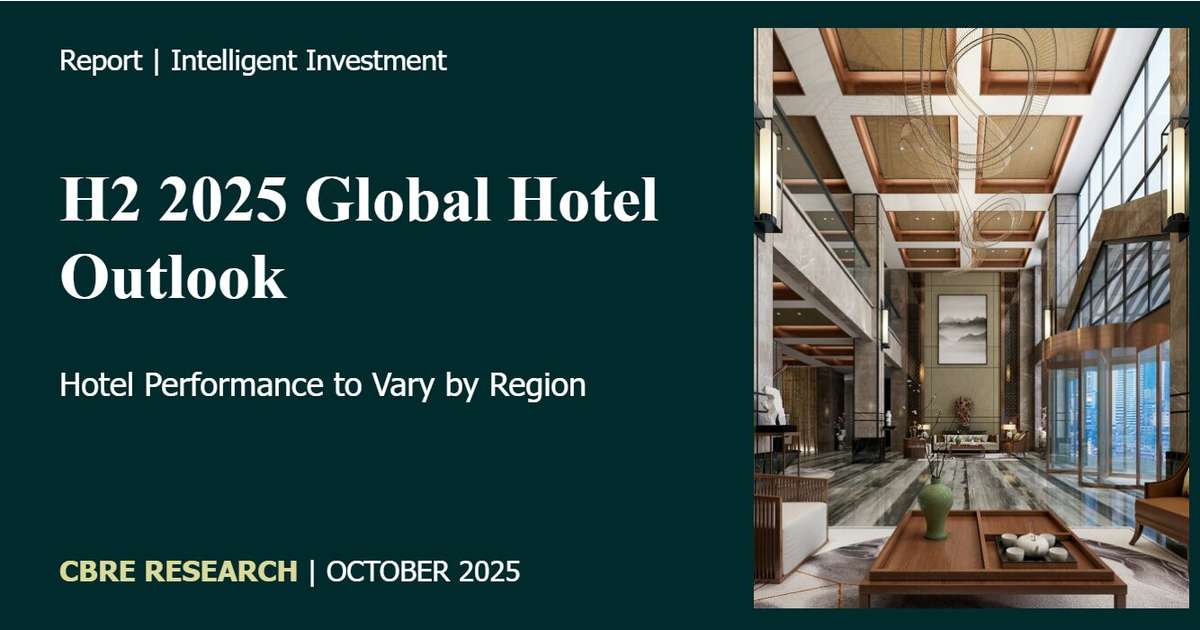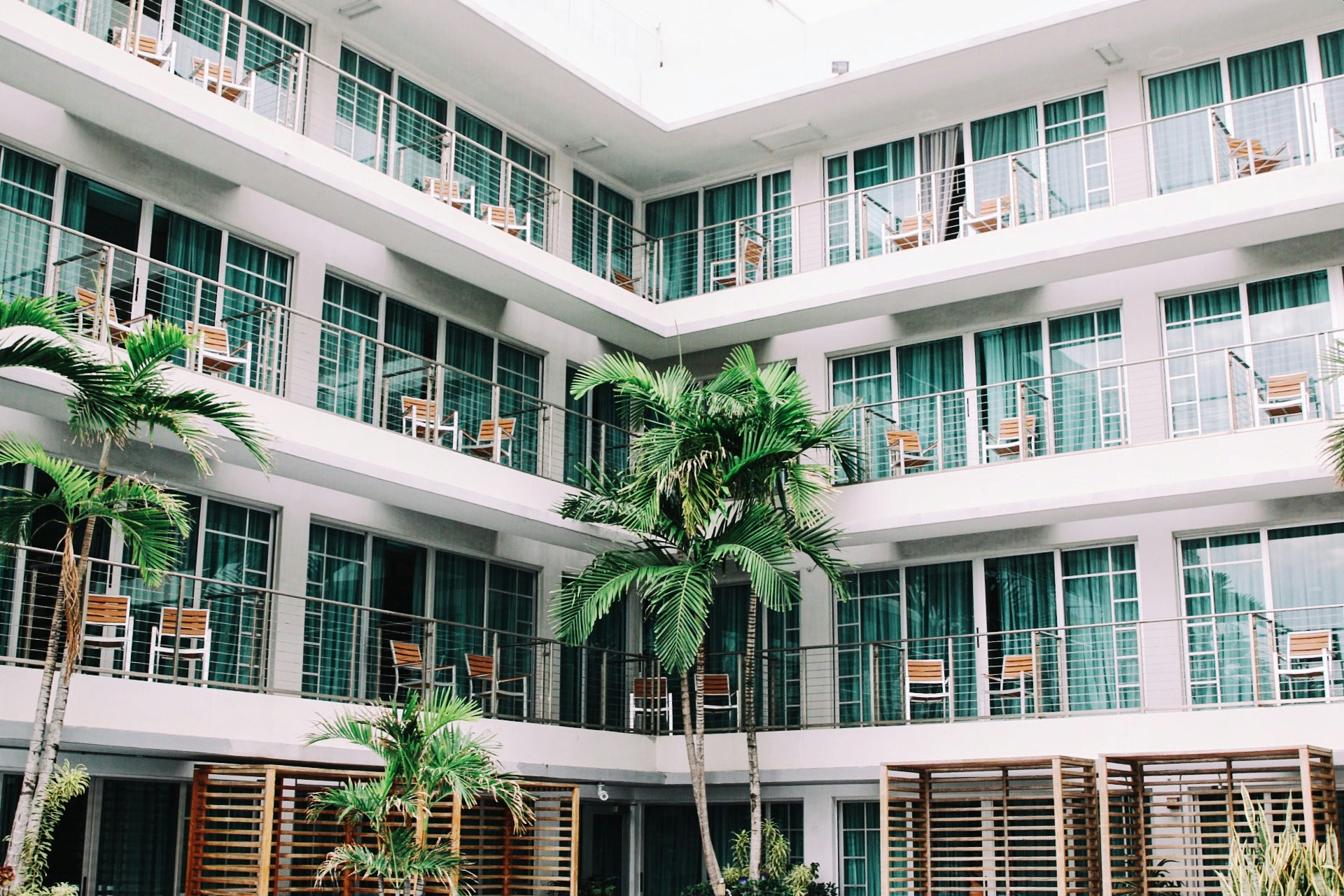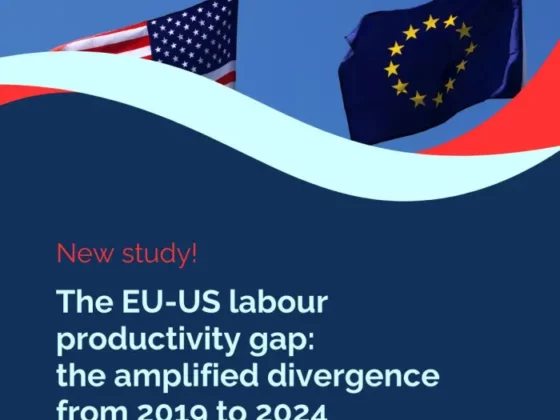
Executive Summary
- In the U.S., CBRE has reduced its 2025 RevPAR growth forecast to 0.1% from 1.8% previously. Hotel fundamentals are expected to undergo more dramatic changes over the next three quarters due to a less active hurricane season and fewer election-related events than last year, as well as tariff increases and continued competition from lodging alternatives.
- Despite trade tensions with the U.S., Canada is still expected to see a 2.4% increase in RevPAR. Inbound travel from the U.S., as well as domestic travel, remains relatively strong.
- Northern Latin America tourism is undergoing a dynamic upswing this year, with Mexico, Costa Rica, Colombia and the Dominican Republic all showing strong performance. Visitor numbers are expected to further increase over the rest of 2025.
- Europe’s international tourist arrivals continue to rise. Certain markets are seeing stronger occupancy rates amid more measured rate setting. We expect decelerated RevPAR growth of between 2% and 5% across Europe this year.
- Middle East hotels and tourism performed well in H1 2025, with the UAE leading the way. Abu Dhabi and Dubai have recorded significant growth in RevPAR, driven by a strong exhibition season and the appeal of new leisure attractions. Most Saudi Arabian markets also recorded RevPAR growth.
- Asia-Pacific saw a 9% increase in international arrivals (excluding mainland China) in the first half of 2025, driven by visitors to Japan, Vietnam and Korea. Growth of average daily rates (ADRs) slowed in most markets. Japan, Korea, Vietnam and India are expected to have the strongest RevPAR growth in 2025.
United States
Despite stronger-than-expected economic growth through the first half of 2025, year-to-date RevPAR growth through July stands at a meager 0.4% as the occupancy rate fell for four consecutive months.
Historically, ADRs tend to contract following four to six months of occupancy declines, which does not bode well for the balance of the year. CBRE now forecasts RevPAR growth of -0.6% for H2 2025, bringing our full-year 2025 RevPAR forecast to just 0.1% year-over-year, down from our earlier forecast of 1.8%.
CBRE lowered its 2025 U.S. GDP growth forecast to 1.5% from 1.9% earlier in the year, reflecting the impact of persistent trade tensions, elevated interest rates and geopolitical uncertainty. CBRE also lowered its 2026 GDP growth forecast to 1.8% from 2.5%, well below the long-term average. Inflation is expected to remain elevated, with CPI growth forecast at 2.9% for the year—10 basis points higher than previous estimates. Along with weaker growth in real disposable income and cautious consumer sentiment, these are expected to weigh on hotel fundamentals for the rest of this year and in 2026.
Following better-than-expected RevPAR gains in Q4 2024 and Q1 2025, growth fell sharply in Q2. This can be attributed to several factors: a modest 0.5% increase in inbound foreign travelers, a drop in meeting and convention attendance, less business travel, government layoffs and a 5.3% increase in the supply of short-term rentals over the past 12 months.
-
0.1% – Forecast growth in U.S. hotel RevPAR this year.
-
12% – CAGR in hotel loyalty program membership since 2019.
Hotel market fundamentals are expected to remain challenged for at least the next three quarters. Year-over-year changes will be more dramatic due to strong demand last year from an active hurricane season and presidential election-related events, as well as flat per diems for travel by government workers, increased tariffs and continued competition from lodging alternatives. These headwinds are compounded by persistent labor challenges and rising operating costs, which are pressuring margins. As alternative lodging options proliferate, hotel margins are expected to decline for the third consecutive year in 2025.
Chain-affiliated hotels have outperformed independents in 2025, supported by a 12% CAGR in loyalty program membership since 2019. Loyalty programs continue to provide a buffer for occupancy during challenging periods, though their impact is partially offset by the 40% cumulative proliferation of brands among the world’s largest hotel families since 2019. Luxury remains the strongest-performing chain scale, while urban hotels lead in year-over-year growth. However, urban hotels still trail their pre-COVID performance levels.
Lower-priced hotels are expected to underperform through the remainder of 2025 and into early 2026, having benefited disproportionately from hurricane-related demand in late 2024 and early 2025.
Additionally, tariffs, inflation risks and the potential for rising unemployment could suppress demand by price-sensitive travelers.
Figure 1: Americas Hotel Performance & Key Macroeconomic Indicators as a % of 2019
CBRE expects San Francisco, Orlando and San Jose to see the strongest RevPAR growth and Memphis, Austin and New Orleans to see the weakest over the balance of 2025 and in 2026. San Francisco and San Jose will benefit from a strong convention calendar and large special events like the Super Bowl and World Cup in 2026. Orlando will benefit from the opening of a new theme park in 2025.
CBRE expects further improvement in hotel fundamentals next year, supported by special events such as the World Cup and the country’s 250th birthday. Even so, top-line growth is expected to remain below inflation for the foreseeable future. With construction and operating costs at all-time highs on a per-available-room basis, CBRE forecasts annual supply growth of just 0.7% between 2024 and 2028, less than half the rate over the four years preceding COVID. Persistent growth in shadow supply will likely delay the hotel market’s next upcycle beyond the near term.
Now in its fifth year, the hotel sector’s recovery has entered its later stages. Operators and asset managers must remain diligent on cost control, while continuing to deliver clean, safe and comfortable guest experiences. Maintaining amenities and service levels is critical to retaining market share, especially as competition from shadow supply and limited-service brand offerings intensifies.
Hotel owners and operators should optimize channel mix, invest in guest-facing services and amenities, retrofit obsolete spaces into revenue-generating outlets where possible and work hard to keep review scores high.
Canada
Heading into 2025, the Canadian hotel market was expected to return to a typical RevPAR growth pattern, characterized by supply and demand balance and moderate ADR growth.
Following several years of strong demand growth and minimal new supply, the national occupancy rate was expected to remain at peak levels (~65%).
New hotel supply was expected to rebound to levels in line with historical norms (~1.5%) after several years of increased construction and borrowing costs, along with closures and conversions of existing properties.
The Canadian hotel market saw significant ADR growth in recent years, including a 4.5% increase in 2024 to more than $200. Strong demand was driven by both leisure and business travel, as well as improved technology that helped operators drive rate yield.
-
2.4% – Forecast growth in Canadian hotel RevPAR this year.
While the initial optimism for steady RevPAR growth faced challenges in early 2025 due to rising trade tensions with the U.S. and economic uncertainty, we still expect a 2.4% increase in RevPAR to $138. This moderate RevPAR growth is based on balanced supply and demand and a moderate improvement in ADR.
Uncertainty about travel demand due to escalating trade tensions with the U.S. have so far proved unfounded, as U.S. inbound travel to Canada has remained relatively strong.
Figure 2: Canada Hotel Performance & Key Macroeconomic Indicators as a % of 2019 Levels
Northern Latin America tourism is undergoing a dynamic upswing this year, with Mexico, Costa Rica, Colombia and the Dominican Republic all showing strong performance.
Mexico led the region with over 15.6 million international tourists between January and April, while the Dominican Republic welcomed more than 4 million visitors in the first four months. Colombia recorded a 6.6% year-over-year increase in international arrivals and Costa Rica, despite a 2.8% dip in early-year arrivals, remains a top destination for eco-tourism.
Hotel development is booming across the region: Mexico added over 2,280 new rooms by May, with Cancun accounting for 75% of that total. The Dominican Republic is undergoing a major expansion with 78 hotel projects adding more than 18,000 rooms, while Costa Rica is preparing 26 new projects to deliver 1,500 rooms by 2026, backed by over $700 million in investment.
The outlook for the rest of 2025 is promising. Mexico expects 3,900 more hotel rooms and a rebound in air travel. Colombia’s tourism sector is set to contribute over $21 billion to its economy and create 1.3 million jobs. The Dominican Republic aims to reach 12 million visitors, with tourism contributing 15.8% to GDP, while Costa Rica forecasts a 1.7% increase in air arrivals totaling over 2.6 million travelers. Together, these countries are driving Northern Latin America’s rise as a global tourism powerhouse.
Tourism across Mexico, Costa Rica, Colombia and the Dominican Republic has shown resilience so far this year amid global uncertainties. Mexico reported a hotel occupancy rate of 58.7% across 70 destinations, slightly below previous years, yet saw a notable increase in international tourists to 15.6 million. Los Cabos and the Riviera Maya stood out for their strong performance. Costa Rica, while facing a slight slowdown in tourism due to limited air travel and global trends, maintained a stable hotel market with a 64.8% occupancy rate and continued to expand its luxury offerings.
58.7% – Hotel occupancy in Mexico across 70 destinations.6.6%Year-over-year increase in international visitors to Colombia.
Economic stability and strategic investments have supported tourism infrastructure and air connectivity across the region. Colombia recorded a 6.6% increase in international visitors during the first five months of 2025, with Bogota, Cartagena and Medellin standing out for their strong arrival numbers and hotel occupancy rates. The Dominican Republic, while experiencing a reduction in flights from North America, expanded its air routes to Europe and is on track to receive over 12 million visitors by the end of the year, contributing significantly to its tourism revenue. Costa Rica also maintained its appeal among high-end travelers, with a 6.5% rise in hotel room capacity in 2024.
Shifting travel patterns are reshaping regional tourism flows. Mexico has seen increased arrivals from Argentina and Canada, while visitor numbers from the U.S., Colombia and the U.K. declined. Colombia’s tourism sector benefited from enhanced international promotion and connectivity. Meanwhile, the Dominican Republic anticipates long-term growth in tourism, with projections suggesting continued expansion and a strong contribution to the national economy. Together, these countries reflect a dynamic and evolving tourism landscape in Latin America.
Figure 3: Northern Latin America Hotel Performance & Key Macroeconomic Indicators as a percentage of 2019
Note: Air passenger data for 2025 is pertains only to Mexico. Source: CBRE Research with information from Oxford Economics, Mexico´s Central Bank, Colombian National Administrative Department of Statistics, Colombian Ministry of Commerce, Industry and Trade, National Institute of Statistics and Census of Costa Rica, the Costa Rican Institute of Tourism, Domincan Republic Central Bank, Tourism Information System of the Dominican Republic, World Bank, CoStar, 2025.
Europe
Europe’s international tourist arrivals continue to rise, broadly in line with earlier projections. The U.S. remains a key source market, with year-to-date monthly arrivals exceeding 2024 and 2019 levels, though stabilization is expected.
Total air passenger volume is forecast to rise by 5% year-over-year in 2025, gradually returning to its longer-term growth path. Some regional slowdowns and downside risks remain. For example, travel from mainland China to Europe continues to recover, though a full return to 2019 levels is now expected in 2026 rather than 2025 as previously projected.
Year-to-date 2025 RevPAR rose by 2.8% from the same period last year. Growth was supported by strengthening occupancy in several key tourism markets, while ADR increases have become more moderate. Earlier concerns over Eastern Europe have generally eased, with Budapest and Warsaw outperforming in both occupancy and room rates.
In some markets, the recent stronger uptick in occupancy has been accompanied by a more measured approach to rate setting, with operators seemingly favoring stable pricing to preserve booking momentum. We expect a deceleration of annual RevPAR growth across Europe to between 2% and 5%, compared with 7% last year.
-
5%Forecast rise in annual air passenger volume.
-
2.8%Year-to-date increase in RevPAR.
As projected earlier in the year, favorable supply and demand dynamics continue to support growth in key tourism markets, though at a more measured pace. Greece, Italy, Spain and France have seen further ADR gains, while occupancy has remained broadly stable. This moderation in growth is expected to persist in the second half of this year.
There have been notable downward revisions in hotel development forecasts for the U.K. and Germany, with several projects delayed. Ireland, Poland and Portugal are forecast to see supply growth at a CAGR of over 1% between 2024 and 2030, which is modest by historical levels but above the regional average.
Figure 4: European Hotel Performance & Key Macroeconomic Indicators as a % of 2019
Middle East
The tourism sector in the Middle East broadly performed well in H1 2025, with only a few outliers in key markets.
The UAE’s main markets all recorded RevPAR growth. Abu Dhabi had the greatest year-over-year improvement, fueled by a strong H1 exhibition season and several recently opened leisure attractions. The continued traction of Abu Dhabi’s Stopover program, which provides travelers on Etihad Airways with a free two-night hotel stay when booking a flight with a stopover in Abu Dhabi, is increasing visitors to the capital.
Dubai recorded a 6.1% year-over-year increase in international visitors totaling nearly 10 million in H1 2025, putting it on pace for a record year. The target of breaking into the top three visited destinations in the world is within reach in the medium term, considering it was comfortably within the top 10 in 2024. The connectivity and the scale of Dubai’s airport is in many ways the lifeblood of the Emirate’s hospitality sector, and the plans to further develop Dubai’s capabilities to handle air traffic over the next decade bode well for the sector.
-
6.1% Year-over-year increase in international visitors to Dubai in H1 2025.
Most Saudi Arabian markets have seen an increase in RevPAR so far this year, including the holy cities of Makkah and Madinah; however, Jeddah and Riyadh saw declines. In Jeddah, this was largely attributable to a shift in corporate activity to the capital and a reduction of spending from the government sector. The decline in Riyadh was partly due to the corporate segment and fewer key events this year. Nonetheless, the long-term outlook for both markets is broadly positive, given government initiatives to further develop both locations.
Figure 5: Middle East Hotel Performance & Key Macroeconomic Indicators as a % of 2019
Asia-Pacific
International tourist arrivals in Asia-Pacific (excluding mainland China) through June jumped by 9% year over year.
Much of this growth is concentrated in Japan, Vietnam and Korea. The Pacific Asia Travel Association forecasts 692 million arrivals in Asia-Pacific this year, up from 648 million in 2024.
Increased tourism has helped to boost hotel performance in Asia-Pacific. While the rate of growth has slowed, ADRs have continued to rise in most markets on a local currency basis. Occupancy has also shown continued growth so far this year, with various markets employing different pricing and operational strategies.
Japan recorded a 17% year-over-year jump in ADR in H1 2025, with record tourism inflows taking advantage of the relatively weak yen.
Korean ADR increased by 6.3% year-over-year in H1 2025, as continued tourism growth supported hotel performance.
Strong levels of new supply in the second half of 2024 caused Singapore ADR to drop slightly year-over-year. Occupancy has seen modest growth, with hotel general managers focusing on length of stay and limiting cost expenditures.
After logging strong growth from 2022 to 2024, Australia has seen hotel performance stabilize as domestic demand normalizes.
-
9% Year-over-year increase in international tourist arrivals in H1 2025.
-
17% Year-over-year increase in Japan’s ADR in H1 2025.
Limited inbound tourist demand and weak domestic consumption have seen ADRs stagnate in mainland China, with occupancy levels dropping year-over-year. Nevertheless, international hotel brands continue to expand in this market. While ADRs have been flat in Hong Kong SAR, occupancy continues to grow, with general managers focusing on filling rooms rather than raising rates.
Hotel performance has varied in Southeast Asia so far in 2025. Vietnam is seeing improved performance from more tourist arrivals. Hotel rates in Indonesia have increased due to falling occupancy levels, particularly in Bali. After a solid 2024, Thailand has seen performance slip as mainland Chinese cancel bookings due to safety concerns.
From a RevPAR perspective, Japan, Korea, Vietnam and India are poised to have the strongest growth this year.






